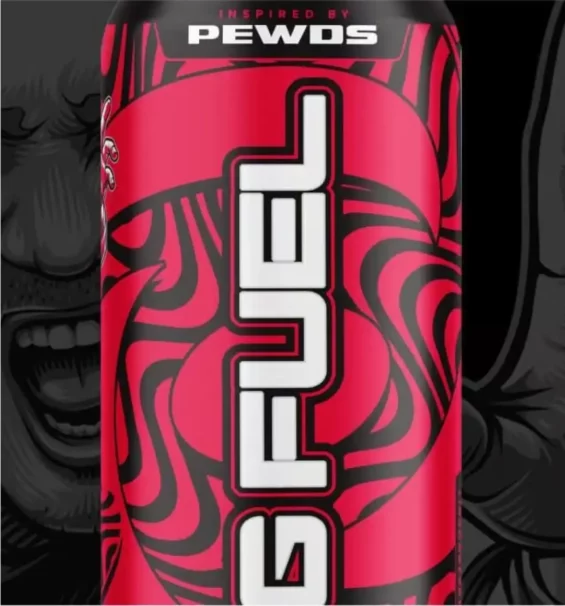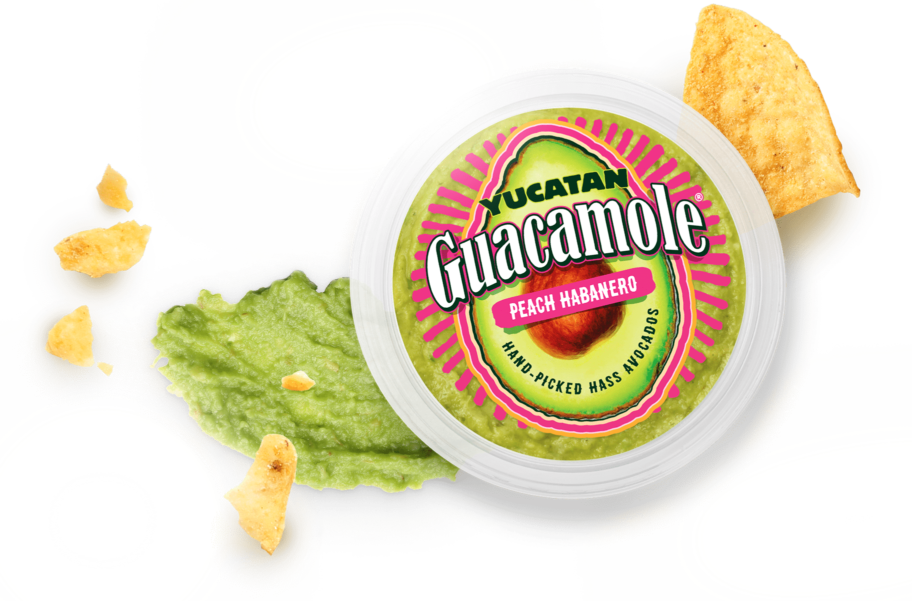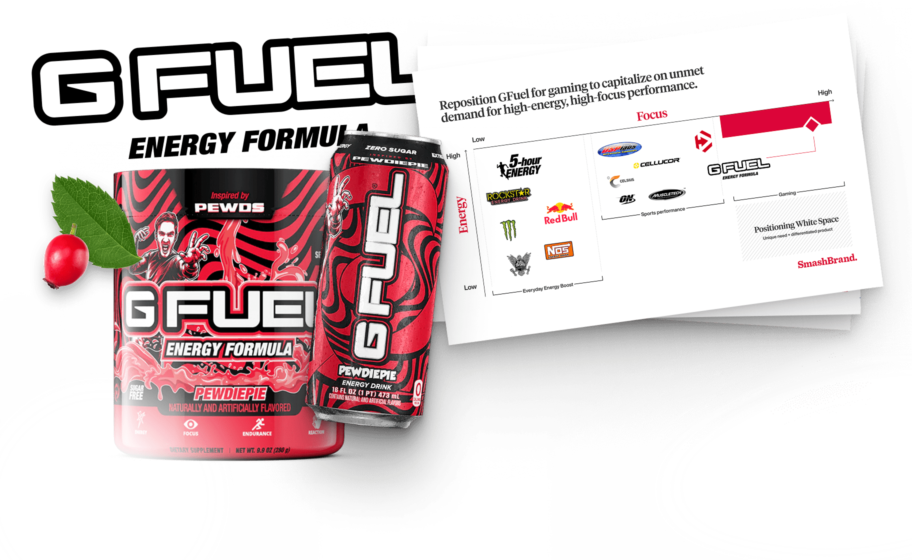Ready to launch the next best food product? Whether you’re a brand new company or looking for a package refresh, this article is the package design framework a food brand needs. This complete guide teaches you how to create a unique food packaging design that captures a category.
Grocery chains don’t settle for shelf mediocrity. Limited space means retailers must decide which food brands to promote and which to discontinue. In the words of the Godfather, “This isn’t personal; it’s strictly business.” Even if your brand has a significant likeability factor, you will be delisted if your food product design doesn’t perform against existing competition and soon-to-arrive challenger brands.
In an industry where patents rarely exist, required food label changes limit flexibility, and private label brands offer lower prices, how do you make your food brand stand out? While having talented designers is a part of the process, it will not get the job done. You must systematically research, design, and test to create the best food packaging design.
A great food packaging design can differentiate between a long-term relationship with a grocery chain and a return to an e-commerce strategy. If you want your food product to live where most commerce happens, you need a design that performs.
In today’s market, competition is so fierce that even produce needs to stand out. The product that consumers understand to have the best food branding will win over what is truly the “best product” on the shelf. From the food packaging logo to the nutrition facts, everything counts.
The Food Package Experience
You now understand the need for a premium packaging design, but how do you design food packaging that looks good and captures the consumer’s attention, leading to repeat purchases? It starts by understanding how shoppers identify, handle, and decide which product to take to the register.
Because of legal restrictions in the food industry and shopper awareness, the CPG industry requires careful consideration for each element of your food product packaging design. Every design element must draw the consumer in, hold their attention, and create alignment between the product and a shopper’s expectations.
A winning food brand design isn’t about who receives the most medals and awards. The genuine success metric for product packaging is how many times it rings through the register. Point blank, accurate brand recognition comes down to product trials, repeat purchases, and company revenues.
You need more than talented designers with unique artistic abilities to succeed on a grocery store shelf. You need packaging, messaging, and design elements that influence and resonate with consumers beyond the point of consideration.
Your food packaging should take consumers from interest to engagement, excitement to satisfaction. How do you achieve this goal? Each product is unique, but there is one thing that all food brands must understand.
Your packaging must be flawless. Every element needs to be strategized, designed, and tested for performance. That’s why working with reputable food packaging design companies is so important. Now, let’s explore how to design food packaging.
How to Design Food Packaging
Many brands rely on a co-packer to handle packaging decisions, trusting them to select the best option. However, this often places critical choices in the hands of unqualified decision-makers, leading to ineffective results.
A strategic custom food packaging design is essential to stand out in a crowded market. Whether it’s coffee packaging design, frozen food packaging design, or chocolate packaging design, brands must prioritize consumer preferences and ensure that nutritional information is clear and compelling.
Using custom packaging with interactive elements engages shoppers and enhances shelf appeal. A distinctive packaging strategy protects the product, influences purchasing decisions, and strengthens brand recognition.
Package Design Strategy
Before considering your package design options, determine an accurate buyer persona by understanding the inner details of their lives. This should be part of every brand strategy, but it needs to be further evaluated for each new product.
Perform Market Research
Why does the established brand dominate mass markets? Because they dominate the data. They say knowledge is power, after all.
Data from market research is critical for big brands at every decision-making level. It drives all product development, packaging, and marketing decisions. Fortunately, not every brand needs budget-breaking data to create a well-defined, differentiated brand from the competition.
All it takes is a little ingenuity and elbow grease.
Leverage all information at your brand’s disposal. This includes industry reports, online discussions, social media, and competitor reviews to understand the current packaging zeitgeist. At SmashBrand, this groundwork is fundamental to our function as your food packaging design company. Our brand development process research involves store visits, informal discussions with target consumers, surveys, and more.
The goal is to understand what your target market wants to see. We aim to identify the primary pain points in the competitive space. This information forms a hypothesis about strengths, opportunities, threats, and risks for research-backed package design.
Find Your Target Audience
What matters to your target consumer? Are they a mom whose kid is screaming in the grocery store? Maybe a Gen-Z who is deliberate about each food purchase?
What encourages your target audience to make a purchasing decision? The primary goal of market research is to identify open areas in your industry that competitors haven’t touched. This presents opportunities to reach untapped markets where you can capture brand loyalty before your competitors.
This differentiation is essential, as retail packaging design has unique challenges compared to other marketing mediums. Since packaging rests directly next to its competition, consumers directly compare each product.
And they don’t spend long doing it— usually only 5-15 seconds —making it essential that the product stand out. Eye-tracking studies show that shoppers never see a third of the displayed brands. Further research shows that being seen quickly correlates with purchase intent, and the value of standing out becomes clear.
But since retailers place competition close to your products, brands must gather all comparable data on their rivals. We need this information to understand which strategies are standard and which are disruptive.
Begin by combining in-store tours and online research of your competitors. Help your design team by taking photos and notes about your experiences. Check online reviews to gather valuable insight into your market’s preferences.
Understanding Your Consumer’s Concerns
Here are some concerns that CPG brands need to meet to satisfy their prospective customers.
Safety Concerns
What long-held and emerging concerns does your ideal customer have? Does your product address them? Don’t hide from those difficult conversations. Instead, face them head-on and solve your audience’s unspoken concerns.
Health Concerns
Does your food product solve a health-related concern for the shopper? Amplify your message about how your product is the right choice for their health objectives. Here is an idea: Show off how “clean” your product is with clear packaging.
Calorie Concerns
Consumers will always be concerned with calories. It is not enough for a high-sugar food to proclaim its low-fat gospel. Nor is it enough for high-fat foods to puff their chest at their low-carb profile.
Consumers are too savvy for that. Your food packaging label design must carefully consider calories and macronutrients. Embrace your low-calorie (or high-calorie) food product. Just be sure that you communicate that message to the right audience.
Deux had the wrong target audience when they appeared on Shark Tank. A group of calorie-concerned consumers criticized this “healthy” and enhanced “functional” food. That said, Deux has embraced its younger demographic, which is less concerned with calories and more concerned with superfoods.
Product messaging done right will increase conversions, but done wrong, it leads to shelf pullback where discounters buy your product for pennies on the dollar.
Social (Culture) Concerns
Farmers from the 1800s might find it odd that we purchase food because we desire to associate with a group of people. But in an introverted society, we seek social acceptance in strange places.
While hipsters may have started the social coffee experience, brands like Death Wish Coffee created their community. Death Wish found a hardcore demographic to build a coffee culture that connects people and gives back to communities.
Taste Concerns
Flavor matters, period! Even the healthiest shoppers make some purchasing decisions based on food taste. Find a balance between just enough hype to excite the customer and not so much that it creates an experience mismatch.
Food packaging design companies should test not only to determine how to display the different flavors to elicit the most significant purchase intent but also to verify that flavor profiles do not become so bold that consumers lose trust before the purchase or find misalignment between their expectations and their first product use.
It’s a tough job, but we must do it if you want your food brand to continue performing on grocery shelves.
Perform a Competitive Analysis
After understanding your food product category and determining your buyer persona, it’s time to see how your brand stacks up. When you engage with a CPG brand strategy agency that offers full-scope food packaging design services, one of their objectives will be to identify where competition is weak or category. This learning and insight expose market opportunities that are not addressed by current products and can reveal tremendous opportunities.
Retail food packaging is unique because it “lives” on cluttered shelves. The packaging must work within the limited time shoppers spend making their purchase decisions. Given this reality, the first challenge is clearly to be seen and considered—creating an opportunity to sell.
Unless you are paying for product placement, retailers position your product next to its primary competitors. Consumers will rarely view and consider your product in isolation. If you want to get noticed, remember this critical point…
The most relevant norm is nearly always competition. You must gather comparable data regarding competitive packaging, including all leading store brands. You cannot be unique and disruptive without knowing the entire competitive landscape.
If you do this yourself, start with in-store tours and online research. Photograph your visits, enabling the design team to see where products live “in the wild.”
When researching online, collect as many images and product reviews as possible. The insights you can gain about likes, dislikes, and opportunities from Amazon reviews will surprise you.
Product Packaging Options
The innovations within the food packaging industry happen faster with each passing year. Do not depend on what you’ve seen in the past or feel forced to follow the latest packaging design trends. Instead, talk to vendors about what new capabilities they have and what innovative options are available.
We take care of this job when you work with a CPG package design agency like SmashBrand.
There are hundreds of plastic and cardboard options to choose from. There are also unique, sustainable packaging options that appeal to an eco-friendly demographic. Somewhere within this fast-moving industry is a specialty food packaging material perfectly built for your product.
But it isn’t just the material’s sustainability where you have options. Innovations in resealable, reusable, and flexible packaging exist. Packing with a post-purchase utility offers food brands a way to stand out, creating social conversations about their product.
Front of Pack Design
They have said that you have three seconds to catch someone’s attention. Thanks to smartphones and our more distracted society, that time is now shorter. You are mistaken if you think your front-of-pack design has 3-seconds of the consumer’s attention.
Stopping consumers in their tracks and capturing their interest is essential for start-ups and companies with strong brand awareness. Not only do you need to stop consumers in their tracks, but you also need to get that product into their hands. Maybe, just maybe, at this point, you have the 3-seconds you were looking for.
Your front package or label panel’s job is to connect with the consumer. The message your packaging delivers doesn’t need to be overly descriptive. It must be short and punchy and stimulate a special moment in the consumer’s mind.
Designing For Other Panels
After reviewing your front panel, your potential customer secretly says, “I feel we have a strong connection to, but I’d like to know more about you.” Additional product panels help build consumer trust by answering questions in advance and creating solutions to problems not yet considered.
A creative food packaging design has high expectations for all aspects of the box, bag, or bottle, including the side panels, rear panel, top panel, & bottom panel. Everything from the UPC to the nutrition facts design is an important detail that requires careful consideration. Innovative food packaging design agencies should leverage purchase drivers and design elements that “miss the cut” from consumer-facing by placing them on the side and rear panels.
Food Label Design
No package? No problem! There are still customizable options for a food label design. Consider adding special label features such as peel-back and double-sided information.
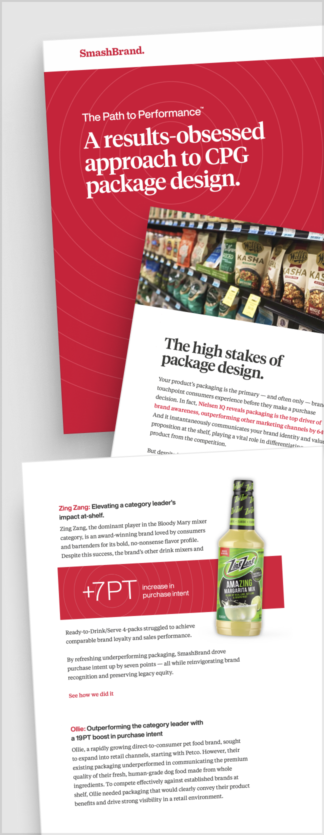
Path to Performance™
Taking a results-obsessed approach to CPG package design.
Learn how SmashBrand’s proprietary process – rooted in scientific principles, informed by data, and validated by your target audience – takes the guesswork out of package design and delivers guaranteed results.
"*" indicates required fields
Define Your Food Packaging Parameters
This is where we need a reality check for all the creatives out there. Unfortunately, while hopeful of making all of our package design dreams come true, the operational side of the business may set us straight. The finance department may have a different idea of a packaging strategy. We will look at other essential considerations in your product packaging to satisfy your CFO and accountant.
Here, we cover the parameters for designing food packaging; we have more research. Brands must define their parameters before they can begin building toward them. These parameters likely include the following:
- Packaging design project goals
- Packaging requirements
- Total budget
- Project timelines
- Project constraints
To help define this framework, brands should ask themselves a series of questions:
- How many SKUs are there?
- How many components are we packaging together?
- How do components correlate with one another?
- What materials are the products made of?
- What is the weight of each component?
- What is the retail price of each SKU?
- Is there a specific budget per SKU for packaging manufacturing?
- Do you know geographic compliance laws for packaging and labeling?
- Are there specific shelf requirements? And what type of shelf will house the products?
- What type of lighting will a store use?
- Is your packaging designed to sell? To warn? Or to display?
- Is there any product information that we must legally include on the packaging?
- Are display windows necessary?
- Should your packaging be easy to dispose of, or should it be sturdy for future repurposing?
- Does the packaging need to be recyclable?
While extensive, this questioning is only part of the consideration necessary for a top-level CPG packaging design. Much like step one, this step of the design process is about understanding how to get your products from the factory floor to the retail shelf.
The Food Packaging Design Process
Now that you have data and packaging parameters figured out, it’s time to bring strategy back into the picture. Let’s move to the preliminary design process.
Ideally, your food packaging designer understands your desire to create a powerful brand in competitive, crowded marketplaces. Hopefully, she has experience with food product branding and has an understanding well beyond general design skills. A better idea is to work with a food branding agency where you work with a team rather than a designer.
Don’t take this decision lightly. It can make or break the entire project. We’ve written extensively on this topic, so make sure you know what to look for.
Design is more than slapping a shell on your product; the team should understand how to bring the product to life, articulating the quality of the product through packaging design. It’s this positioning, this attitude, that allows businesses to unlock untapped opportunities existing in their markets.
To convert shoppers into customers through effective packaging design, your package needs to follow several fundamentals.
Design With The Store In Mind
Packaging doesn’t exist in a vacuum—the realities of the physical store environment play a large role in design.
- Consider how retailers and customers don’t always face goods correctly on the shelf after holding them.
- Pay attention to how hanging tags block products on the shelves below them.
- Notice how building lights cause reflections or shadows.
While we cannot control some of these factors, brands must understand their impact when creating food packaging designs. These aspects may influence the packaging substrates used, whether using dual PDPs and where to place the most critical messaging on the packaging.
At SmashBrand, as your food packaging design agency , we will test your package design in a simulated retail environment, mimicking a shopper who has experience with your product on the store shelves.
For example, we’ve examined brands in the packaged, sliced deli-meat category whose products advertised “more product for your money” in the top left corner of the packaging. Unfortunately, the retailer’s sales tags concealed this copy from the consumer.
Without clarifying the cost of the product was due, in part, to the volume of food the customer received, it appeared the product was expensive for its category. Over the weeks and months, how many customers decided against purchasing because of this simple oversight? Ouch!
Differentiate And Stand Out
Standing out on the shelf in high-volume retail is difficult when a single store has over 30,000 products for consumers to browse. Making an impact in this market means being bold and trying different strategies than other brands on the shelf.
Don’t be afraid to break the rules, push your brand, and move outside your comfort zone. Brand differentiation is key for standing out, and most products blend in.
But remember, differentiation must have a meaningful purpose—being different for the sake of being different won’t produce results. Make sure your unique brand positioning actually matters to shoppers in your category.
For example, consider how a kid (and mom) felt the first time they read “limited edition toy inside” on a cereal packaging design . This message addresses both the parent and the child, helping to establish more product value for a nominal cost.
Sometimes standing out requires more than a single feature. With the rise in sustainable packaging, finding other purchase drivers that reach this customer profile reinforces the product’s value. A triple threat in this category would be:
- Eco-friendly packaging made from sustainable materials.
- Environmentally friendly, reusable packaging .
- Multi-purpose packaging.
Position and communicate these product features well; you will beat the average “natural” product.
Dial Back Your Corporate Tendencies
Customers choose a product based on what the brand reveals about their character. We understand this synchronicity as brand resonance. Consumers prefer brands that have personality, originality, and real people behind them.
Because of this, we’re in the middle of what could be called a “counter-corporate” movement in packaging design.
Bland stock images, generic taglines, and other overly manufactured styles serve little purpose in food packaging design. Instead, consumers prefer brands that express themselves; they prefer charming, opinionated, and quirky brands that are transparent on the shelf.
This means brands must avoid dedicating packaging space to self-serving corporate claims, prominent calls-to-action, and shopworn promises that consumers hear from every company. They must approach the packaging design process with a human mindset and ensure the packaging connects with shoppers on a deeper level.
Dedicate space in your design to elements catering to your target market’s broader interests, such as activities or social causes. Customers also appreciate brands that show their humanity and include warm, inviting designs in their packages.
Finding The Right Purchase Drivers
People can love your brand and believe in your mission, but that is not enough for a brand to succeed. Without the right purchase drivers, your product will sit on the shelf marking down the days until its expiration date arrives.
Besides a strong brand identity, your message needs to create purchase intent. A critical aspect of your food packaging branding is messaging that matters, speaking distinctly and more impactfully than the competition.
Clarify Your Value Proposition
To start, what does your product stand for? Make your brand value proposition obvious so your target demographic cannot miss your message. While you shouldn’t scream, “HEY, NATURAL SHOPPER!” There are ways to communicate this message properly on the front of the package (or should you). The correct pattern interrupts the message from the package to the mind, seemingly at the speed of light.
purchase drivers
Staying on packaging design for food considered “natural,” it may be a single ingredient that brings home the uncured pastured bacon for your natural food item. However, in a category where natural ingredients are common purchase drivers, you may need a unique way to format that message. The best packaging design for food products will always be the one that unpacks the words that drive the most purchase intent.
Nonverbal Drivers
Many brands forget the synergistic relationships between what we see and read. Traditionally reserved for brand identity, nonverbal drivers in your food packaging graphic design increase message strength that words alone may not accomplish.
Great packaging uses verbal and nonverbal drivers to influence a consumer’s purchase decision. At SmashBrand, we believe testing is necessary for product messaging with and without non-verbal drivers.
Food Package Design Testing
Food brands at every level can perform package design testing. Even with a penny-pinching budget, you can test your packaging through digital ads, product demonstrations, or simply asking how people feel about a design. But not every brand testing agency creates tests that provide the feedback you need to compete in tough environments.
Let’s look at some ways you can test your food package designs.
Consumer Validation Testing
The last step in your food products packaging strategy involves validating your proposed designs with representatives from your target market. Reach out to your product’s target audience and tell them what you’re doing. Set the stage by:
- Identifying where they are (e.g., the cereal aisle in the grocery store)
- The context of what they’re doing (choosing a new cereal brand)
- What they’re looking for (low sugar, healthy options). Under this framework, present the packaging design to them. Gather specific feedback, allowing you to fine-tune the messaging before you create attractive packaging.
From here, let’s take a quick step back and assess the goals of packaging design:
- Attract customers
- Associate specific products with specific brands
- Effectively communicate what the product is
- Demonstrate what makes the product unique over similar competitors
With these goals fresh in our minds, the value of consumer validation testing becomes clear. Customer feedback is a simple way to measure the effectiveness in a setting that resembles the actual buying experience.
The best outcome from this process, of course, is discovering that nothing needs to change. However, we’ve seen brands discover costly design or messaging mistakes through this process. Our package testing methodology saved them a tremendous amount of money and hassle. Getting in front of this problem before it hits the shelves prevents friction between the brand and the retailer.
We strongly recommend that brands perform brand testing with consumers before sending their products to the shelf. This process is simple to do and maximizes design potential while minimizing risk. It’s also important to note that the best consumer feedback comes from aim, third-party sources not affiliated with the brand.
Consumer testing relies on unbiased feedback.
Package Design Testing Free of Subjectivity
At SmashBrand, we take a different approach to package design testing. When you work with our food package design agency, the consumer’s actions determine the total purchase intent. Through our package testing process, we calculate the effect a design has on brand recall.
We don’t want subjective opinions or how they “feel” about a product. Sure, it’s a start and narrows down some factors, but we must remove potential mismatches between what someone says and what they do. Only a simulated buying environment with an accurate competitive landscape provides the data we need to compete against the top food brands.
Repeated the Testing Process
Rinse, wash, repeat. Testing once is not enough. Through iteration, you can get your product packaging closer to a straight line from the shelf to your ideal consumer.
Launch & Distribution
You’re finally ready. You’ve followed the above steps, performed all necessary research, and are ready to launch your product. If you’ve performed each step, your brand has a leg up on the competition, but realize that the challenges aren’t over yet. Stores give a new product a six-to-nine-month incubation period to prove its value, so smaller brands typically only have one shot to get it right.
Getting your product on the grocery store shelves is difficult, but be persistent and don’t give up. All brands initially pound the pavement to prove themselves, generate consumer interest, and make the right connections. Attend trade shows in your market to network with distributors, suppliers, and marketing professionals who can help.
Using a broker may be helpful when trying to break into large national retail chains. If you’re trying to make it into smaller gourmet shops, the owners will be more willing to hear direct pitches from producers.
Some companies, such as Whole Foods, often introduce small brands on a regional scale, testing out how they’ll perform. These can be viable options for brands hoping to break into the market. Even if a brand starts as a regional brand, the right move is to work with food product packaging companies that can improve its positioning and consumer appeal. This sets the stage for future growth.
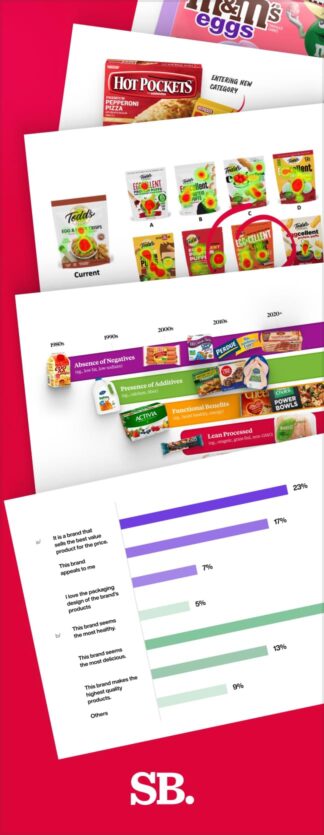
Nice Package
Don’t miss out on our monthly newsletter Nice Package!
Each month, we deliver a data-driven newsletter directly to your inbox, unpacking a critical topic in the FMCG & CPG industry.
"*" indicates required fields
More Than A Food Package Design Agency.
SmashBrand is a brand development agency for FMCG and CPG companies. From brand strategy to packaging design testing, our Path To Performance™ process guarantees a retail performance lift.
Our passion is helping our clients create new brands or revitalize their existing ones. We put our heart and soul into every project, designing standout brand experiences that embrace innovation, creativity, and ideation for game-changing packaging design ideas.
We’ve owned successful brands and know what it takes to compete in crowded markets. Regardless of your product, our team has the knowledge and insight needed to make yours win. Book a time to discuss your project with our team.
Subscribe to
Nice Package.
A monthly newsletter that unpacks a critical topic in the FMCG & CPG industry.
Free Resource.
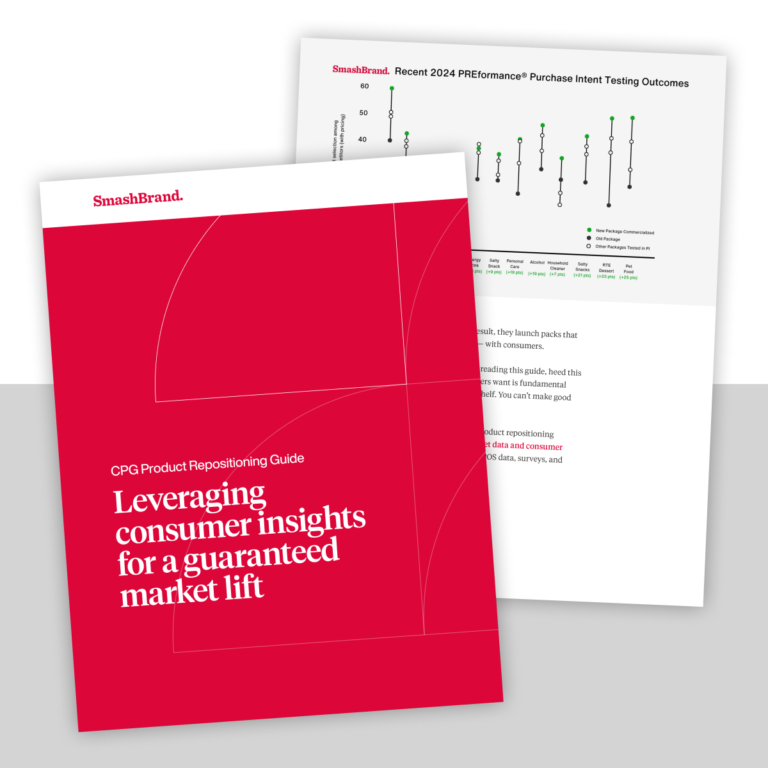
CPG product repositioning guide.
Explore the five undeniable signs your CPG product needs repositioning along with strategies for leveraging consumer insights for a guaranteed market lift.
Learn More About CPG product repositioning guide.
